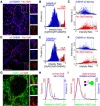Differential GABAergic and glycinergic inputs of inhibitory interneurons and Purkinje cells to principal cells of the cerebellar nuclei
- PMID: 25009273
- PMCID: PMC6608357
- DOI: 10.1523/JNEUROSCI.0401-14.2014
Differential GABAergic and glycinergic inputs of inhibitory interneurons and Purkinje cells to principal cells of the cerebellar nuclei
Abstract
The principal neurons of the cerebellar nuclei (CN), the sole output of the olivo-cerebellar system, receive a massive inhibitory input from Purkinje cells (PCs) of the cerebellar cortex. Morphological evidence suggests that CN principal cells are also contacted by inhibitory interneurons, but the properties of this connection are unknown. Using transgenic, tracing, and immunohistochemical approaches in mice, we show that CN interneurons form a large heterogeneous population with GABA/glycinergic phenotypes, distinct from GABAergic olive-projecting neurons. CN interneurons are found to contact principal output neurons, via glycine receptor (GlyR)-enriched synapses, virtually devoid of the main GABA receptor (GABAR) subunits α1 and γ2. Those clusters account for 5% of the total number of inhibitory receptor clusters on principal neurons. Brief optogenetic stimulations of CN interneurons, through selective expression of channelrhodopsin 2 after viral-mediated transfection of the flexed gene in GlyT2-Cre transgenic mice, evoked fast IPSCs in principal cells. GlyR activation accounted for 15% of interneuron IPSC amplitude, while the remaining current was mediated by activation of GABAR. Surprisingly, small GlyR clusters were also found at PC synapses onto principal CN neurons in addition to α1 and γ2 GABAR subunits. However, GlyR activation was found to account for <3% of the PC inhibitory synaptic currents evoked by electrical stimulation. This work establishes CN glycinergic neurons as a significant source of inhibition to CN principal cells, forming contacts molecularly distinct from, but functionally similar to, Purkinje cell synapses. Their impact on CN output, motor learning, and motor execution deserves further investigation.
Keywords: cerebellar nuclei; glycinergic; immunohistochemistry; interneurons; mixed inhibition; optogenetics.
Copyright © 2014 the authors 0270-6474/14/349418-14$15.00/0.
Figures







Similar articles
-
Hyper-Formation of GABA and Glycine Co-Releasing Terminals in the Mouse Cerebellar Nuclei after Deprivation of GABAergic Inputs from Purkinje Cells.Neuroscience. 2020 Feb 1;426:88-100. doi: 10.1016/j.neuroscience.2019.11.030. Epub 2019 Dec 14. Neuroscience. 2020. PMID: 31846755
-
IPSC kinetics at identified GABAergic and mixed GABAergic and glycinergic synapses onto cerebellar Golgi cells.J Neurosci. 2001 Aug 15;21(16):6045-57. doi: 10.1523/JNEUROSCI.21-16-06045.2001. J Neurosci. 2001. PMID: 11487628 Free PMC article.
-
Co-localization of glycine and gaba immunoreactivity in interneurons in Macaca monkey cerebellar cortex.Neuroscience. 2006 Sep 15;141(4):1951-9. doi: 10.1016/j.neuroscience.2006.05.012. Epub 2006 Jun 19. Neuroscience. 2006. PMID: 16784818
-
GABAergic inhibition in the neostriatum.Prog Brain Res. 2007;160:91-110. doi: 10.1016/S0079-6123(06)60006-X. Prog Brain Res. 2007. PMID: 17499110 Review.
-
Diversity of neuronal elements and circuitry in the cerebellar nuclei.Cerebellum. 2012 Jun;11(2):420-1. doi: 10.1007/s12311-011-0350-6. Cerebellum. 2012. PMID: 22278661 Review.
Cited by
-
What Is the Involvement of the Cerebellum During Sleep?Neurology. 2023 Mar 21;100(12):572-577. doi: 10.1212/WNL.0000000000207161. Neurology. 2023. PMID: 36941065 Free PMC article. No abstract available.
-
Altered synaptic and firing properties of cerebellar Purkinje cells in a mouse model of ARSACS.J Physiol. 2018 Sep;596(17):4253-4267. doi: 10.1113/JP275902. Epub 2018 Jul 19. J Physiol. 2018. PMID: 29928778 Free PMC article.
-
Developmental Changes in Serotonergic Modulation of GABAergic Synaptic Transmission and Postsynaptic GABAA Receptor Composition in the Cerebellar Nuclei.Cerebellum. 2018 Jun;17(3):346-358. doi: 10.1007/s12311-018-0922-9. Cerebellum. 2018. PMID: 29349630
-
Tonically Active α2 Subunit-Containing Glycine Receptors Regulate the Excitability of Striatal Medium Spiny Neurons.Front Mol Neurosci. 2018 Jan 9;10:442. doi: 10.3389/fnmol.2017.00442. eCollection 2017. Front Mol Neurosci. 2018. PMID: 29375305 Free PMC article.
-
Differential Coding Strategies in Glutamatergic and GABAergic Neurons in the Medial Cerebellar Nucleus.J Neurosci. 2020 Jan 2;40(1):159-170. doi: 10.1523/JNEUROSCI.0806-19.2019. Epub 2019 Nov 6. J Neurosci. 2020. PMID: 31694963 Free PMC article.
References
-
- Bäurle J, Grüsser-Cornehls U. Differential number of glycine- and GABA-immunopositive neurons and terminals in the deep cerebellar nuclei of normal and Purkinje cell degeneration mutant mice. J Comp Neurol. 1997;382:443–458. doi: 10.1002/(SICI)1096-9861(19970616)382:4<443::AID-CNE2>3.0.CO;2-2. - DOI - PubMed
Publication types
MeSH terms
Substances
LinkOut - more resources
Full Text Sources
Other Literature Sources
